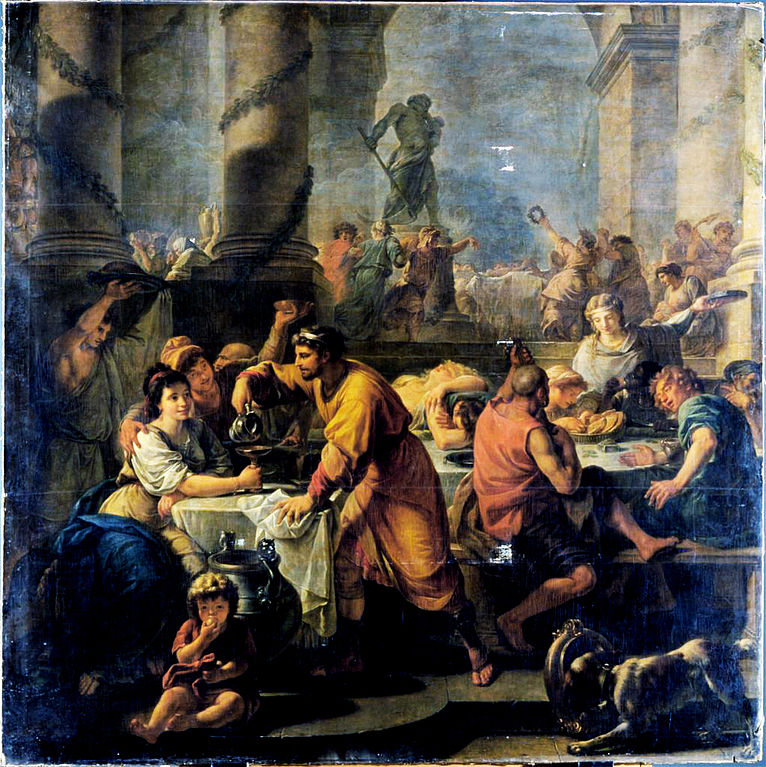Saturn
Saturn is the sixth planet from the Sun and the second-largest in the Solar System, after Jupiter. It is a gas giant with an average radius of about nine and a half times that of Earth. It only has one-eighth the average density of Earth; however, with its larger volume, Saturn is over 95 times more massive.
The Romans named the seventh day of the week Saturday, Sāturni diēs ("Saturn's Day"), for the planet Saturn.
Observation
Saturn has been known since prehistoric times, and in early recorded history it was a major character in various mythologies. Babylonian astronomers systematically observed and recorded the movements of Saturn. In ancient Greek, the planet was known as Φαίνων Phainon, and in Roman times it was known as the "star of Saturn."
Moons and rings
The moons of Saturn are numerous and diverse, ranging from tiny moonlets only tens of meters across to the enormous Titan, which is larger than the planet Mercury. There are 146 moons with confirmed orbits, the most of any planet in the solar system. Before the advent of telescopic photography, eight moons of Saturn were discovered by direct observation using optical telescopes.
The modern names for Saturnian moons were suggested by John Herschel in 1847. He proposed to name them after mythological figures associated with the Roman god of agriculture and harvest, Saturn (equated to the Greek Cronus).
The rings of Saturn are the most extensive and complex ring system of any planet in the Solar System. They consist of countless small particles, ranging in size from micrometers to meters, that orbit around Saturn. The ring particles are made almost entirely of water ice, with a trace component of rocky material. There is still no consensus as to their mechanism of formation.
Exploration
The exploration of Saturn has been solely performed by crewless probes. Three missions were flybys, which formed an extended foundation of knowledge about the system. The first probe to visit the Saturnian system was Pioneer 11 in 1979, which revealed that Titan was probably too cold to support life. The Cassini–Huygens spacecraft, launched in 1997, was in orbit from 2004 to 2017.
Huygens was an atmospheric probe that touched down on Titan on January 14, 2005, discovering that many of its surface features seem to have been formed by fluids at some point in the past. Titan is the most distant body from Earth to have a space probe land on its surface.
The Huygens probe landed just off the easternmost tip of a bright region now called Adiri. The probe photographed pale hills with dark "rivers" running down to a dark plain. Current understanding is that the hills (also referred to as highlands) are composed mainly of water ice. Dark organic compounds, created in the upper atmosphere by the ultraviolet radiation of the Sun, may rain from Titan's atmosphere. They are washed down the hills with the methane rain and are deposited on the plains over geological time scales.
Mythology
In ancient Hebrew, Saturn is called Shabbathai. Its angel is Cassiel. Its planetary intelligence or beneficial spirit is 'Agȋȇl (Hebrew: אגיאל, romanized: ʿAgyal), and its planetary spirit is Zȃzȇl (Hebrew: זאזל, romanized: Zazl). Zazel has been described as a great angel, invoked in Solomonic magic, who is "effective in love conjurations". In Ottoman Turkish, Urdu and Malay, the name of Zazel is 'Zuhal', derived from the Arabic language (Arabic: زحل, romanized: Zuhal).
In ancient Roman mythology, the planet Phainon was sacred to this agricultural god, from which the planet takes its modern name. The Romans considered the god Saturnus the equivalent of the Greek god Cronus; in modern Greek, the planet retains the name Cronus—Κρόνος: Kronos.
Saturn is named after the Roman god of wealth and agriculture and father of Jupiter. Its astronomical symbol (♄) has been traced back to the Greek Oxyrhynchus Papyri, where it can be seen to be a Greek kappa-rho with a horizontal stroke, as an abbreviation for Κρονος (Cronus), the Greek name for the planet. It later came to look like a lower-case Greek eta, with the cross added at the top in the 16th century to Christianize this pagan symbol.
The Roman festival of Saturnalia was named for the god Saturn.
The Olympic spirit Aratron rules over Saturn.
In Kabbalah, Saturn rules over the sefirot of binah and its opposing qlippoth Satariel.
Astrology
In astrology, Saturn represents the traits: industrious, melancholic, and tranquil.
Saturn rules over Capricorn and Aquarius. Western astrology appraises Saturn as the primary native ruler of the tenth house. In traditional Hindu astrology however, Saturn ruled both the first and eighth houses, and had its joy in the twelfth house of mischief and bad luck.
Dante Alighieri associated Saturn with the liberal art of astronomia (astronomy and astrology).
In Chinese astrology, Saturn is ruled by the element earth, which is warm, generous, and co-operative. In Indian astrology, Saturn is called Shani or "Sani", representing a noteworthy career and longevity. He is also the bringer of obstacles and hardship.
According to Heinrich Cornelius Agrippa, chalcedony is a stone under the planets Saturn and Mercury.

